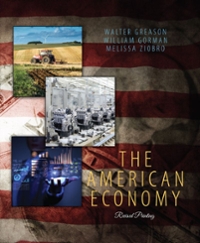Question
Soybeanfuturesonthe Chicago Board of Trade tumbled to their lowest level in nearly two weeks, as speculators sold amid forecasts for benign cropweatherand broad-based financial-market weakness.
Soybeanfuturesonthe Chicago Board of Trade tumbled to their lowest level in nearly two weeks, as speculators sold amid forecasts for benign cropweatherand broad-based financial-market weakness.
The spot September contract dropped 86 cents or 7.8% to $10.14 a bushel, while the most-active November contract fell 24 cents or 2.5% to $9.555 a bushel. The November contract reflects crops currently growing in the U.S. that will be harvested in autumn.
Prices forsoybeans, especially for nearby contracts, had rallied previouslyonsupply concerns. Supplies from last year's harvest are tight and there were worries that the crops currently growing would be subject to an early freeze that would kill immature crops.
But beneficial cropweatherin the Midwest, where mostsoybeansare grown, along with falling crude-oil prices, declining equities and a firmer U.S. dollar, was the perfect formula to pressure prices. Analysts said speculators who boughtonthe freeze worries recently were forced to sell as prices dropped.
"The market is at the mercy ofweathermaps, and without any frost or freeze threats, traders are taking someweatherscare premium out of prices everyday without a crop threat," said Joe Victor, analyst with the research and introducing brokerage firm Allendale Inc.
Weatheralways is important forsoybeans. This crop was planted so late because of a wet spring and the Midwestern growing season has been so cool, worries about an early frost were heightened. The supply worries comeonthe heels over strong demand from China, the number one importer ofsoybeans. China has turned to the U.S. for the oilseed because of reduced supplies from Brazil and Argentina, the second- and third-largest suppliers.
Those supply concerns are beginning tofallby the wayside, however. Because there weren't any hot spells this summer, and if the U.S. crop can escape a September freeze, there is great potential for record production, agronomists said.
The market is vulnerable to further selling under normal seasonal conditions, and without any recent fresh demand news from China, buyers remain cautious in the face of a firmer U.S. dollar, and weakness in crude oil and equities, said Mike Zuzolo, president Global Commodity Analytics & Consulting LLC.
CRUDE OIL: Futures ended lower, as investor confidence in a quick U.S. economic recovery faltered. Oil followed other markets, which fell after mild intraday gains were posted, despite a report showing the U.S. manufacturing sector expanded in August for the first time since January 2008. Light, sweet crude oil for October delivery settled $1.91, or 2.7%, lower at $68.05 a barrelonthe New York Mercantile Exchange.
NATURAL GAS: Futures fell as a supply glut and mildweatheroutlook outweighed signs that demand for the fuel was rising. Nymex October natural gas settled 15.6 cents, or 5.2%, lower at $2.821 a million British thermal units.
a) Although the total size of the harvest of a particular crop like soybeans in the fall is limited by how much was planted in the spring, there are costs associated with harvesting, processing, and transporting the crop to market. Explain how these costs will result in an upward sloping supply curve.
Begin by drawing a supply-demand diagram for soybeans. Label the initial supply and demand curves S0 and D0. Each of the following parts asks you to relate a statement from the article to changes in the equilibrium. If the statement suggests a shift in supply, label the new supply curve S1. If it suggests a shift in demand, label the new demand curve D1. If the article suggests more than one shift, label the curves S1, S2, etc. For our purposes, we will not differentiate between the soybeans futures market and the spot market. Explain you diagram in a sentence or two.
b) "Soybean[s] tumbled to their lowest level in nearly two weeks ... amid forecasts for benign crop weather and broad-based financial-market weakness."
c) "Prices for soybeans ... had rallied previously on supply concerns. Supplies from last year's harvest are tight and there were worries that the crops currently growing would be subject to an early freeze that would kill immature crops."
d) "But beneficial crop weather in the Midwest, where most soybeans are grown, along with falling crude-oil prices ... and a firmer U.S. dollar, was the perfect formula to pressure prices [in a downward direction]." Note: a stronger U.S. dollar makes exports less attractive, and in a typical year much of the U.S. soybean crop is sold abroad.
e) "The supply worries come on the heels over strong demand from China, the number one importer of soybeans. China has turned to the U.S. for the oilseed because of reduced supplies from Brazil and Argentina, the second- and third-largest suppliers." Consider total demand as being made up of demand from the U.S. and China, and total supply as being made up as supply from the U.S., Brazil, and Argentina.
Step by Step Solution
There are 3 Steps involved in it
Step: 1

Get Instant Access to Expert-Tailored Solutions
See step-by-step solutions with expert insights and AI powered tools for academic success
Step: 2

Step: 3

Ace Your Homework with AI
Get the answers you need in no time with our AI-driven, step-by-step assistance
Get Started


